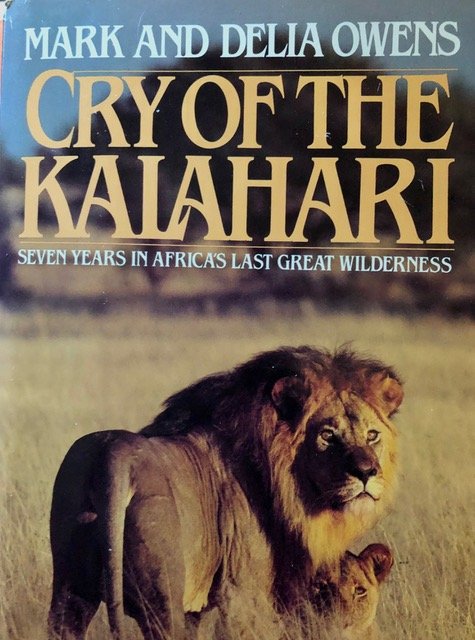Where the Crawdads Sing
In 1974, Mark and Delia Owens met in a protozoology class at the University of Georgia. A visiting scientist told them about Africa’s disappearing wilderness, reporting “More than two-thirds of its wildlife had already been eliminated, pushed out of its habitats by large ranches and urban sprawl.” And in the southern regions, “thousands of predators were being trapped, shot, snared, and poisoned to protect domestic stock.” Perhaps what shocked the two young idealistic students the most was learning that in some African nations, conservation policies and practices were virtually nonexistent.
In their 1984 book, Cry of the Kalahari: Seven Years in Africa’s Last Great Wilderness, the couple wrote, “We became determined to study an African carnivore in a large, pristine wilderness and use the results of our research to help devise a program for the conservation of that ecosystem. Perhaps, also, we simply wanted to see for ourselves that such wild places still exist.” They feared that if they didn’t go immediately, there might be little left to study. They would go on to conduct research and conservation projects on endangered species in Africa for 23 years, co-authored three books, and appeared in a 1988 National Geographic documentary, “African Odyssey.”
Of their solitary years in Botswana’s vast Central Kalahari Desert, they wrote “we were the only two people, other than a few bands of Stone Age Bushmen, in an area larger than Ireland.” When asked if they ever saw anybody, Delia Owens replied, “No. Not unless people came to our camp, and that was very, very rare.” Now divorced from Mark, Delia has continued to write. At the age of 70, she published her first novel, Where the Crawdads Sing in 2018. It holds the record for the most weeks at #1 on the New York Times Bestsellers list for Hardcover Fiction and continues to be a phenomenon with fans and book clubs. While on book tours, she finds herself on stage speaking to packed audiences—a rather terrifying experience for a woman who has spent years of her life living in isolation. It is precisely there, in that solitary place we go when the world is too much, that Owens connects with her readers.
While I was still living in Missouri, my “Book Club of Two” friend Marjo Price loaned me her own copy of Where the Crawdads Sing. The author’s name immediately rang a bell. I recalled that Kit and I were working at National Geographic when the Owens’ documentary, “African Odyssey,” was produced by the Society. In the summer of 1988, we attended a fundraiser for Delia and Mark Owens organized by the Friends of the Pittsburgh Zoo to help fund the couple’s wildlife conservation efforts in Africa. After viewing the documentary, we shared a table with them at the dinner and learned firsthand details of how they documented the natural history of Kalahari lions and brown hyenas—totally cut off from the outside world.
Photo by Mark Owens taken at their Kalahari camp.
In my home travel library, I have a copy of the Owens’ first book, Cry of the Kalahari, with this inscription: “For Cathy and Kit, thanks for the pleasure of an evening together and for all you are doing to foster an appreciation of our natural world. Come share a campfire with us sometime. Best wishes always, Mark Owens and Delia Owens, 20 June,1988.” I never had an opportunity to share a campfire with them, but Marjo, her husband Al Price, and their sons had. In that remarkable way that circles come round, I learned that Delia had sent two copies of her novel—published 30 years after Kit and I met her—to Marjo and her son Lake who spent three months in 1979 working in the Owens’ camp when he was fourteen years old.
The New York Times Book Review has described Where the Crawdads Sing as “Painfully beautiful…At once a murder, a coming-of-age narrative, and a celebration of nature.” It is indeed all that, and oh, so much more. A film adaptation of the novel has been produced by Reese Witherspoon’s film production company and will hit movie theaters in July 2022. Witherspoon read the novel as part of her Instagram book club after its release in 2018. She fell in love with the story that follows a young woman abandoned by her family as a child who survives for years on her own in the marshes of Barkley Cove, North Carolina.
Picture of the author by Mark Owens.
While writing her novel, Delia Owens lived in a remote corner of northern Idaho near the Canadian/Montana border and now lives in the mountains of North Carolina. The seed that blossomed into her novel—set in the remote marshlands along the North Carolina coast not far from Georgia where she grew up—came from something that she often felt while living in a remote camp in Africa—the feeling of being alone and far from home, of living in isolation, and of not having a group to belong to. According to Owens website, “Her research on the importance of female groupings in social mammals influenced her fictional writing. Where the Crawdads Sing explores the behavioral impact on a girl who is forced to live much of her young life without a group.”
I encourage you to read this haunting, beautifully written novel. And join the author’s followers like Kit and me who are now rereading the novel in anticipation of the film adaptation’s summer release.



